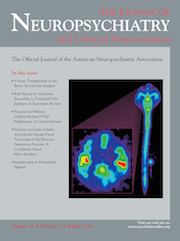To the Editor: Generally associated with right hemisphere and frontal lobe pathology, reduplicative paramnesia is a content-specific delusion that a familiar place has been duplicated or relocated. We present a patient status after a right fronto-temporal cerebrovascular accident (CVA) who subsequently developed reduplicative paramnesia.The delusional misidentification syndrome (DMS) is a rare neuropsychiatric phenomenon that can occur in both medical and psychiatric conditions. Reduplicative paramnesia (RP) is a content-specific DMS in which a patient misidentifies a familiar place, with delusional conviction.
1 There does appear to be a consensus that RP may have a neurologic rather than psychiatric cause and that right and bifrontal lesions are common factors in its presentation.
2 We present here the case of a patient with new-onset reduplicative delusions status post-right frontotemporal infarct.
Our patient is a 66-year-old man with history of a CVA and residual left-sided hemiparesis, admitted for “confusion.” Ultimately diagnosed with delirium due to sepsis, the latter was treated successfully with broad-spectrum antibiotics, which resolved his delirium. Although he returned to his cognitive baseline (Mini-Mental State Exam: 28/30) he developed the delusion that his hospital room was actually his home. When asked, he would reply, “everybody is telling me that I am in the hospital, but this is my house.” Physical examination was remarkable for 4/5 left-sided hemiparesis. Computed tomography scan showed right frontal and parieto-occipital cortical and subcortical infarcts. Magnetic resonance imaging done 4 months before this admission showed multifocal right cerebral acute infarcts with frontal/parietal/temporal distribution. He was treated with risperidone up to 1 mg bid, with significant attenuation of his delusion after 17 days of treatment.
DMS is a neuropsychiatric syndrome in which a patient misidentifies familiar people (Capgras, Fregoli’s syndrome) or places/objects (RP) and believes that they have been replaced or transformed.
1Our patient displayed symptoms of RP noted about 5 months after his right frontotemporal CVA. Interestingly, we are not the first to report a case of RP after two temporally separated, bilateral consecutive strokes.
3Similar to our patient, patients with RP usually have lesions in the right hemisphere and/or bifrontal area. One study reviewed the anatomic correlates in a selected series of case reports of patients with misidentification/reduplication. They found that bilateral cortical involvement occurred frequently (41% of patients). In considering cases in which cerebral dysfunction was unilateral, the authors found that right hemispheric predominance in reduplication was highly significant (52% right hemisphere versus 7% left hemisphere).
4A dual mechanism is postulated for the delusional misidentification syndromes/RP: negative effects from right hemisphere and frontal lobe dysfunction as well as positive effects from release (i.e., overactivity) of preserved left-hemisphere areas. A combination of perceptual impairment and reasoning bias creates the basis for delusion; that is, right temporal–limbic–frontal dysfunction gives rise to a distorted sense of familiarity (temporal/limbic) and impaired ability to resolve the delusion via reasoning (frontal).
1,5 Left-hemisphere overactivity (posited also to play a critical role in the pathogenesis of delusions) develops after right-sided inhibition is lost.
1Multiple treatments for RP have been reported;
2 however, with a limited evidence-base to guide our patient’s treatment, our patient was started and improved on risperidone.
While rare, our patient’s case should remind clinicians to screen for DMS/RP, status post–right-sided CVAs.

